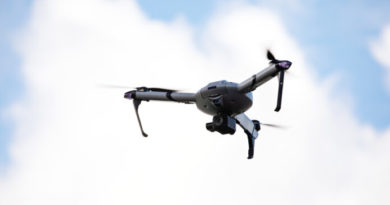The Year of the Drone: Three UAV trends to expect in 2019
In early 2018, we asserted it would be a defining year for the commercial UAV industry – and it was.
In 2018 we increasingly saw the value of drones in real world applications. The year was marked with growing adoption across industries from UAV’s delivering vaccination and blood supplies in developing countries to assisting search and rescue teams as well as procurement and utilization by law enforcement and security organizations.
We also saw 2018 as a year of “miss-use and abuse” with a number of notable incidents including a video recording above a commercial aircraft landing in Las Vegas’ McCarran Airport, a suspected mid-air collision with an Aeromexico 737, the forced grounding of flights at Gatwick Airport during the holiday season as well as the use of drones for terror, including an alleged failed assassination attempted of Venezuela’s President, Nicolás Maduro.
We expect trends of maturation to continue in 2019 and believe mass adoption of professional sUAS will occur. In parallel, we believe the commercial industry will continue to consolidate and begin to capitalize on the real value of these flying vessels, for data creation and cargo transportation.
1. Regulations – better for commercial, worse for consumer
As noted by Imperial Capital in its recently published Monitor report, 2018 was a notable year with meaningful progress towards a clearer regulatory framework with new mandates for the FAA. As expected, we saw regulation toughening for recreational use, the result of drone miss-use by uncertified pilots with consumer UAV’s. Concurrently, we witnessed an opening for commercial applications taking off.
With passing of the FAA Reauthorization Act of 2018, we witnessed the repeal of the 1981 advisory circular and Section 336, cancelling the carve out for model aircraft and recreational sUAS. Included in the bill are clear regulations for recreational operation, demanding more from the leisure drone pilots including a 400ft altitude ceiling, drone registration, prior authorization for flights near controlled air space, as well as passing a test given by the FAA and maintaining a certification in order to fly.
For commercial operators, we did not see a significant change to operations from passing of the new bill, as the requirements remain similar to what was already in place. Moreover, we observed an increase in the granting of waivers for commercial applications with the UAS Integration Pilot Program. In the program 10 states partner with commercial companies in order to test new use-cases with UAV’s such as delivery of goods and medicines, other health-beneficial items issues and logistics. These UAV’s will fly beyond visual line of sight (BVLOS) and above people, which we believe is a signal for a path to clear regulation and eventual widespread usage.
Looking to 2019, we expect regulation to continue in the same direction whereby waivers for commercial operators will be easier to come by and more stringent rules and enforcement will occur for recreational pilots. As seen with the Gatwick incident, enforcement remains difficult, but we see government agencies eager to address security concerns and believe there will be wider market adoption of anti-drone systems. In the U.S., the recent FAA bill includes mandates for reviews and work towards implementation of counter-drone solutions as well as develop a cohesive strategy for enforcement. Deploying these technologies will enable the FAA and law enforcement agencies to halt UAV operations occurring outside the permitted rules established in the recent Reauthorization Act.
2. Market consolidation:
Looking back at 2018, we saw a year characterized by industry consolidation across hardware, software and drone-service companies. Companies without a clear business model and / or low product capabilities were unable to reach mass markets, as potential commercial customers were looking for clear cost-effective solutions for their specific use-cases – the key for adoption in both opex and capex industries. Numerous UAV companies changed business models including their hardware offering and markets served, some even moving into the automotive sector to partake of a larger ecosystem. Other UAV companies were acquired, merged or winded-down all together. We think this is positive as it represents the industry’s growing as it continues to trend towards maturity which will continue in 2019.
In 2019 the surviving companies will drive adoption of UAV technology while creating value for their customers – at scale. We will continue to see collaboration between hardware platforms and software, and these companies will be able to address the needs of the huge market that will define the professional drone industry. For example, the security and defense industry will continue to be a leader of adoption as they have the benefit of less stringent regulation including carve-outs for specific uses, better budgets and a more developed understanding of the use-cases. This understanding and usage will pave the way for adoption in the larger commercial sphere.
3. Logistics is taking off
While we think 2019 will be the year of “UAV-as-a -Sensor”, it will also be a year for UAV-based logistics. We believe there will be continued progress in designing and the eventual launching of new unmanned aircraft that can take heavy cargo over large distances.
The potential for a UAV that can carry 700 pounds over 70 miles, while powered by electrical propulsion and remaining cost-effective is a game changer for the aerospace industry. It will represent the end of the helicopter era and will open the sky to new ideas, from last 50-mile delivery to moving large supplies in industrial facilities and Urban Aerial Mobility.
Reviewing 2018, it was a great year for UAV logistics and large platforms with many companies entering the domain. Uber Elevate’s declaration for human transportation, announced planned pilots in the U.S and Dubai. We saw the introduction of at-least 50 different models for a “larger drone”, “hybrid vessels” or “electric helicopter.” While a great start, we think 2019 will symbolize progress in two important aspects:
- The “Cargo UAV’ ecosystem.” A fully integrated system that includes a UTM system which can combine all these aircraft. It will be used initially to regulate the flight of micro UAVs and will be tested in both the U.S and the EU as a new global system. In addition, we will witness initial infrastructure ideas for such unmanned aircraft and their combination with fixed facilities within a city, as well as testing in-user experience that will enable the usage of this technology by the masses.
- The development of revolutionary aerodynamics and electric propulsion. We are firm believers the real revolution will come when a Cargo UAV can fly electrically over large distances carrying large cargo. For this to happen, there needs to be further innovation in aerodynamic design and propulsion mechanisms that capitalize on the electric energy sources available today. Only an electric vessel with these capabilities will enable a transition from an idea, even phenomenon, to a real-world, cost-effective and operationally capable solution.
These three trends of 2019 will make it a crucial year for the professional UAV industry. The easing of regulation and granting of waivers for demos, trails of new business models and scenarios, together with industry consolidation and organic growth will open the door to mass adoption. Increased adoption and subsequent wider use will improve trust and confidence in airworthiness of these aircraft, and with a better ecosystem and new technologies, will get our industry one step closer to maturity.

Guest post by Guy Cherni
Guy Cherni is the CMO of Atlas Dynamics, a designer and manufacturer of professional sUAS



